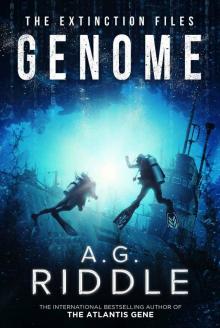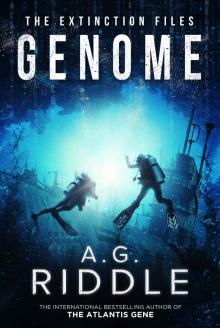- Home
- A. G. Riddle
Winter World Page 15
Winter World Read online
Page 15
We don’t reach a consensus. We break and return to our departments.
Shortly after, Grigory drifts into the lab.
“If we send the other drones on search, we need to be ready to support them.”
“Madre Two,” Harry begins, but Grigory holds up a hand.
“Not talking about bigger mother drone. Talking about fact we have two ships now. One possibly without purpose.”
To my surprise, he doesn’t elaborate. He nods and floats out of the lab. His meaning isn’t lost on James, Harry, or me. But we don’t discuss it. We all return to our work, stewing on the idea.
The next day, James, Harry, and I form a plan. We don’t include the Fornax in it. Mostly because we’re scared to make plans for the ship—because those plans might sentence that crew to death.
In the bubble, the meeting about the drone deployment is contentious. Battle lines are drawn. Harry, James, Grigory, and I are for sending the remaining drones along the vector to search for more artifacts and a potential mother ship.
The rest are against, some more vocally than others.
Min points at James. “This isn’t our mission.”
“Of course it is. Our mission is to do whatever we have to do to save Earth.”
Min taps on his panel. “The mission—”
“Is more than what’s written in the briefing, Min.” James is mad. He’s trying to hide it, but he’s losing control. “Why do you think they sent us up here? To follow that document to the letter? No. We’re here to use our heads and figure this out. We need to find that mother ship.”
James looks at the group. “Odds are, it’s out there. And if these artifacts are responsible for the Long Winter, we’ve got to fight them at the source. There could be millions or even billions of these artifacts.”
Arguing ensues, voices rising. The fight, more than any of our time here on the Pax, reveals the personalities of the members of our crew.
Min, ultimately, is by the book. He favored finding the second artifact, but only because he felt that effort was well within the mission parameters. He can’t imagine going home and telling his superiors he went off on a completely different mission than what he was sent up here for.
Izumi is with him. Maybe her training as a physician has taught her to be conservative. Or perhaps she’s against our idea because it’s so radical.
For Charlotte, the sticking point is the prospect of losing the drones—of having a successful first contact and no way to adapt her approach.
Lina is somewhere in the middle. The German programmer is the least talkative of the crew. She simply asks what the risks and rewards are, which sparks another James-Min standoff.
I think Harry favors the plan mostly because he likes building the drones, and I think he would follow James anywhere. I would too. But I also agree with the plan on the merits. My gut tells me the artifacts are hostile. That’s not just because I think they destroyed the ISS and killed my crew. The evidence supports it.
Grigory is in that camp: he thinks we’re at war. He favors, in his words, “finding our enemy.”
In the end, Lina votes with us, and a compromise is struck: parts for three small drones will remain on the Pax. That wins Charlotte over, leaving Min and Izumi. Neither of them is comfortable with the decision, but they will work to support it. And in private, James and Min apologize to each other for shouting.
We’re becoming more than a crew. We’re becoming a family, one that fights and compromises and cares about each other, even when we don’t agree. Even when we’re mad at each other.
The run-up to the Fornax rendezvous is hectic. It’s anybody’s guess which will happen first: the Janus fleet reaching Beta or the docking.
James and Harry obsess over the drone designs for the third fleet, which they’re calling “Midway” after the decisive naval battle that turned the tide of World War II in the Pacific. Harry, in addition to being a human repository of movie quotes, is a history buff as well. James is too, but to a lesser extent.
“Without Midway, the Japanese could have run the board,” Harry says, strapped to our work table in the drone lab. “Brilliance, that’s what it was. The greatest game of naval strategy ever played.”
I wonder if that’s what Harry thinks we’re doing out here: an elaborate strategy game against an enemy that looks as if it’s winning. And will win.
“The US fleet took down four Japanese carriers at Midway. Four of the six that attacked Pearl Harbor. The Japanese never recovered. Couldn’t replace those ships. Or the pilots they lost.”
James is untangling a ball of wires. “You could argue Guadalcanal was just as important.”
Harry pauses. “True. But that was a land campaign.” He smiles. “Our fight is in the air.”
I enjoy listening to them debate history. I’ve never had much interest in military history, but their enthusiasm brings it to life. I’ve learned more about the War in the Pacific the last two days than I have in my life.
They’ve named the elements of the drone fleet to align with their historical counterparts. There will be three carrier drones—Hornet, Yorktown, and Enterprise—and almost a hundred small scout drones, which don’t warrant names, just the designation PBY and a number. I had to ask what a PBY was (answer: a sea plane used extensively for scouting, rescue, and anti-submarine operations in the 1930s and 40s).
Finally, there are two specialty drones. Vestal is a large, slow drone with all the excess parts. The carriers will be able to offload parts from it as needed. And Mighty Mo is a battle drone with four rail guns and a huge battery to power them. It even looks mean. James and Harry laughed when they settled on the name. Apparently it’s the nickname for the USS Missouri, a storied US battleship that hosted the Japanese surrender. It was the last battleship the US commissioned and the last battleship to be decommissioned.
It also turns out James and Harry are a bit superstitious. They’ll only name the drones after “successful” ships. Harry tells me the US never lost a battleship at sea, though four were sunk during the attack on Pearl Harbor. It’s amazing the history you learn on an impromptu space mission.
My only worry is that Izumi might take offense at the carrier names. I go as far as asking her about it, but she simply stares back with a blank expression and says, “Why would that bother me?”
“Well, you know, because of the war.”
She nods absently. “No. It doesn’t bother me.”
I probably just earned myself a psych eval.
I’m in my sleep station, dead to the world, when the shouts wake me. I try to focus on the words, but I can’t make them out. Something in Chinese, and Japanese, and Harry yelling, “ET phone home!”
The curtain yanks back and James lets his momentum carry him into the cramped space. He’s nearly on top of me, his lips inches from mine.
“We did it. The Janus fleet reached Beta. We’ve got observational data. And first contact. It’s communicating with us.”
Chapter 30
James
I feel like a sailor, marooned on a desert island who has just seen a sail on the horizon. I don’t know if we’ll be saved, or if it’s even a friendly sail, but it’s hope. That’s what first contact with the artifact means. Hope. Hope that we can communicate. Negotiate. Find a way to survive.
In the bubble, Charlotte is practically buzzing. Everyone is here. Emma, sleepy-faced. Min, looking stoic as usual. Grigory, hair in a mess, expression skeptical. Lina and Izumi are uncharacteristically animated, and Harry and I are overjoyed.
I want Emma to hear everything.
I hold a hand up. “Let’s take it from the top—and record it for posterity.”
Everyone sits a little straighter as Harry activates the bubble’s camera. Grigory even runs a hand through the rat’s nest on his head, to no avail.
Harry goes into his official voice. He has a very good official voice. “The crew of the Pax is happy to report that on mission day ninety-two we have made contact with Beta, the second ar
tifact identified in our solar system. The alien construct is currently transiting the system, destination unknown, but on an intercept course with the Sun. As the mission log states, we launched a fleet of drones, Janus, to search for the first artifact, Alpha. They were unsuccessful. A second fleet of drones, Icarus, located Beta, and the Janus fleet was re-routed to it. Janus contains two scout drones and three specialized drones: observation, communication, and intervention.”
I can’t help but smile at the term “intervention.” Sounds better than “rail gun drone” or “battle drone.” Harry doesn’t miss a beat.
“The observation drone performed a successful fly-by, taking visual and other passive non-emissive readings. That drone will rendezvous with us in approximately twenty hours. We’ll reach the artifact in twelve days. And we’ll link up with the Fornax in four days. With that said, I’ll turn it over to Charlotte Lewis, the mission’s first contact specialist.”
Charlotte’s Australian accent seems a bit more pronounced than before. I’m sure we’re all thinking that this video could be shown around the world—and even watched for generations to come. Assuming there are future generations.
“Our first contact protocol was to issue a series of simple mathematical challenges in a variety of wave forms: microwave, radio wave, and light, for example. Our first mathematical sequence was the Fibonacci numbers. Zero, one, one, two, three, five, eight, and so on.” She inhales. “I’m happy to report that after the communications drone issued the forty-sixth number in the Fibonacci sequence, the artifact responded with the forty-seventh. For the first time in the history of the human race, we have made contact with an extraterrestrial intelligence.”
This feels like a good place to cut the video. Charlotte’s enthusiasm oozes through, and whoever is watching, wherever they are, whenever they are, will feel what we’re feeling right now.
Excitement.
Hope.
I give Harry a quick hand motion, and he taps his tablet.
“Recording ended.”
“Okay,” I begin. “The plan has always been to comm-brick major updates to home. I say we send one right now and include this video.”
The group agrees, and we break and reconvene when the brick is on its way to Earth. It’s the first communication we’ve sent. I can’t help feeling a little pride that it carries good news—and ahead of schedule.
Min opens the meeting.
“Well, let’s discuss.”
“I wish I were there,” Charlotte says.
“Depending on what it does to that drone, you may not,” says Grigory.
“Meaning?” she shoots back.
Grigory shrugs. “Meaning is clear. Drone could be in pieces by now.”
I hold up a hand. “We need to talk about whether our plans should change.”
Emma speaks first. “I for one am optimistic. Maybe it’s because I want to believe, but I tend to think this could be a break. Alpha summarily destroyed or disabled the probe—”
“A probe that spied on it without permission,” Charlotte says.
Grigory scoffs. “Spying is always without permission.”
“My point,” Emma says, cutting off Charlotte’s retort, “is that this is clearly a change in behavior. Granted, the drone acted differently than the probe, but the fact remains: upon learning of the drone, Beta didn’t react aggressively. What does that mean? Maybe this artifact is at war with the other.”
The idea hangs in the air a long moment. If true, it complicates matters. And gives us a potential ally. And a chance of ending the Long Winter.
“Maybe,” Harry says, “whatever is happening in our system is related to that war? One side needs solar output somehow or is compromising it? Or maybe we’re linked to one side in ways we don’t understand.”
I’m surprised when Lina speaks. “Maybe we’re a descendant race—one side’s offspring. Or biological drones.”
Interesting theories. You never know what someone’s thinking, especially the quiet ones.
Min speaks next.
“Or we could be simply caught in the middle. One side wants to protect us for moral reasons.”
“The question,” Harry says, “is whether we should alter our plans based on this information.”
“Of course,” Charlotte says. “We need to increase our speed and get to Beta as quickly as possible.”
“Reason?” Grigory asks.
“The reason is obvious,” Charlotte snaps. “We need to be there to communicate. Adapt our approach. This is the most important event in human history, and we’re taking our sweet time getting there.”
“We are not taking sweet time,” Grigory says. “We are flying through space at a significant fraction of speed of light. We are going fast.”
“And we could be going faster.”
“Has cost,” Grigory mutters.
“Which is?”
“Less energy for drones. Reactor can only produce so much. We need the excess for Midway.”
Charlotte is exasperated. “I can’t believe we’re even still thinking about launching the Midway fleet. I mean seriously.” She looks around at the group. “We’re talking about launching a fleet of drones to look for other artifacts when we’ve got one right in front of us that’s already talking to us?”
I shake my head. “Midway is about more than that, Charlotte. We can’t just make double time to Beta and put all our eggs in one basket.” I get blank stares from Min and Izumi. I have to dial back the idioms. “We need to take action that prepares Earth for all possibilities. One successful communication with one artifact isn’t the end of this.”
Harry offers a welcome break in the argument. “Remind us, Charlotte, what the next step is in your first contact protocol.”
“Right.” She inhales. “The scout drone was programmed to return to us the minute first contact was made. The comm drone actually received the Fibonacci response fifty-two hours ago.”
“And while the scout drone returned to us, what’s the first contact drone been doing?” Emma asks.
“Following protocol,” Charlotte replies. “It’s advancing to more sophisticated vocabularies, trying to establish a rich communication method. The primary goal is to convince the artifact that we’re intelligent and peaceful.”
In my thirty-six years of experience with the human race, I’ve found both points debatable.
“We’re closing the distance to the artifact quickly,” I say. “The original plan was to send the scout drone back to Beta, observe any further progress in communication, then return to us. Based on our speed and distance, its next round trip would be about forty-four hours—if we dispatch it now. So I favor sending the scout drone back, keeping our planned rendezvous with Fornax, and continuing the construction and launch of the Midway fleet. Thoughts?”
“I agree,” says Grigory.
Min: “I do too.”
Emma: “Yeah, same here.”
Harry: “Charlotte’s point is worth considering, but I still feel we need to find out what other artifacts may be out there.”
Izumi: “I agree with James.”
Lina: “The observation drone arrives in twenty hours, correct? It will have full data from the fly-by of Beta?”
I nod. “Correct.”
“And the scout drone will return in forty-four hours with more data on first contact. In that case, I favor following our plan unless the data from the observation drone reveals a reason to change.”
With that, the meeting breaks. Charlotte isn’t happy, but we’ve all had our say. This mission is a lot more complicated than I ever imagined.
Every section of the ship and every department lead to the bubble. The energy of the crew coalesces there. Our opinions clash there. And in the storm, we make our plans better. Consensus is forged.
But back in the lab, Harry, Emma, and I are mostly on the same page (with the glaring exception of balancing Emma’s health and workload). When the three of us get back to the lab, the tension from the b
ubble is gone. Harry pulls me into a bear hug. Emma joins us, and I pull her close.
“We did it,” Harry says. “Can you believe it?”
“I can’t,” Emma whispers. “I went into space hoping to do work that would lead to a human colony someday. But this—contact with an alien life form—it’s beyond my wildest dreams.”
I like seeing her like this: happy, inspired. A kid again.
This moment is the best I’ve felt in a long, long time.
I can barely sleep the night before the observation drone arrives.
We’re all sitting in the bubble, staring at the widescreen, when it comes into view. It looks just like a small asteroid. Min issues docking instructions via the comm patches on the outside of the Pax. The drone maneuvers alongside us and into the open bay we’ve prepped for it. When the exterior hatch closes, Izumi floats in, suited in her EMU. She plugs the drone into the ship, and Lina’s software interface begins pulling the data in.
“Don’t wait for me,” Izumi says over the comm. We’re all excited to see the artifact, and every second counts now.
Lina’s fingers work furiously, sorting the data. The screen switches to a video feed from the drone. All eyes are glued to it. Everyone is silent.
Beta hangs in the distance. The sun is behind the drone, illuminating the front of the artifact. The previous image, taken by the probe, was from the rear, the sun in the distance, the artifact simply a dark blur before the blazing sun. The drone zooms closer to the artifact, and several things strike me. First, its size and shape. From this angle, the outline of the object appears circular. I can’t tell yet whether it’s a sphere or if perhaps we’re looking at the end of a cylinder. But it’s large. It must be a mile across. Maybe two. The drone does the math. In the lower right-hand corner of the video, white text appears against the black of space:
Estimated width: 2.4 km
Estimated height: 2.4 km

 The Atlantis Gene: A Thriller
The Atlantis Gene: A Thriller The Solar War (The Long Winter Book 2)
The Solar War (The Long Winter Book 2) The Extinction Files Box Set
The Extinction Files Box Set The Atlantis Trilogy Box Set- The Complete Series
The Atlantis Trilogy Box Set- The Complete Series Winter World
Winter World Genome
Genome Pandemic (The Extinction Files Book 1)
Pandemic (The Extinction Files Book 1) The Atlantis Gene: A Thriller (The Origin Mystery, Book 1)
The Atlantis Gene: A Thriller (The Origin Mystery, Book 1) Departure
Departure Genome (The Extinction Files Book 2)
Genome (The Extinction Files Book 2) The Atlantis World (The Origin Mystery, Book 3)
The Atlantis World (The Origin Mystery, Book 3) The Atlantis Plague: A Thriller (The Origin Mystery, Book 2)
The Atlantis Plague: A Thriller (The Origin Mystery, Book 2)